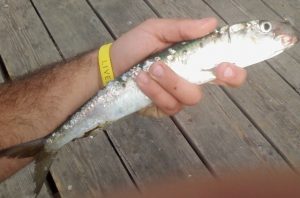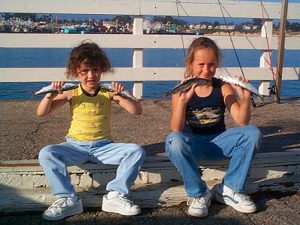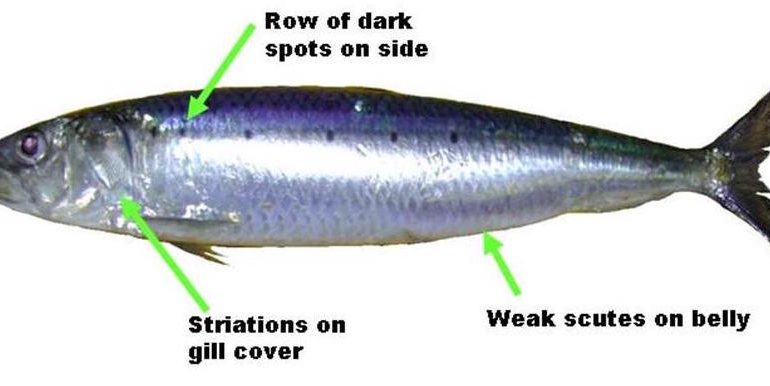Herring: Family Clupeidae
Species: Sardinops sagax (Jenyns, 1842); from the Latin word sardine (sardina), the Greek word ops (like), and the Latin word sagux (of quick perception, acute or alert).
Alternate Names: Pilchard, ‘dines, dinies (small sardines) and dinos, firecrackers (small sardines), rhinos or trout (large sardines). Called sardina Monterrey in Mexico.
Identification: Cigar-shaped like herring but blue green above, silverfish-white below, and identified by a series of black spots on the back. (Fish Bulletin #28 said they had dark green coloring on the back with opalescent reflections, shading into iridescent silvery sides with round black spots of varying degree).
Size: Up to 16 1/4 inches but most caught from piers are under a foot in length.

Range: Islas Galápagos, Gulf of California, and Baja California, to Kamchatka, Alaska, Commander Islands, Russia (Bering Sea) and south of Japan. Commonly seen from Baja California to Oregon and Washington although some years common to British Columbia.
Habitat: Pelagic in nature but generally in nearshore waters including the surf zone. At times, moves into shallower water and bays but typically found from the surface down to about 80 feet (although recorded down to 1,256 feet and possibly 3,221 feet). They generally travel in very large schools called “shoals” and frequently school with Pacific mackerel, jack mackerel, and anchovies. As many as ten million fish have been recorded in a school but most schools contain one million or less fish; the schools are typically found within 100 miles of shore
Piers: Sardines experience tremendous up and down cycles in numbers and when up, they will be one of the most common fish at the piers, when down they may be totally absent from the catch. I have caught them at 28 piers ranging from the state’s southernmost pier, the Imperial Beach Pier near the Mexican border, to the state’s most northerly pier, Citizen’s Dock in Crescent City, just over 20 miles from the Oregon border. Nevertheless, they are by far most common at the central California piers between Pismo Beach and Half Moon Bay, common at SoCal piers, and less common at piers north of San Francisco. Interestingly, reflecting the up and down cycles, I had never caught a sardine at a California pier from 1962 until 1990 when I landed a few at the Seal Beach Pier and Belmont Veterans Pier in Long Beach. Thereafter, I began to catch them at many piers and by 1994 had experienced absolutely phenomenal fishing at several piers (especially those in the Morro Bay area). From that point on until the last few years I’ve seen continued catches (with the most recent being at the Cabrillo Mole in Avalon in 2021). Best bets when present: Newport Pier, Balboa Pier, Hermosa Beach Pier, Port Hueneme Pier, Gaviota Pier, Pismo Beach Pier, Avila Pier, Port San Luis Pier, Morro Bay T-Piers, Cayucos Pier, San Simeon Pier, Monterey Wharf #2, Capitola Wharf, Santa Cruz Wharf and the Johnson Pier in Pillar Point Harbor.

Sardines from the Santa Cruz Wharf
Shoreline: Rarely taken from shore excepting in bays—Morro Bay, San Francisco Bay and Humboldt Bay.
Boats: Rarely taken from boats unless “making bait.”
Bait and Tackle: Light tackle. Generally caught on bait rigs like Lucky Lura or Sabiki outfits. Also can be caught on size 8-10 hooks fished with a small piece of pile worm or very small strip of anchovy. Puts up a very credible fight for its size.
Food Value: Considered somewhat superior to its cousin Pacific herring. The flesh is soft with fine flakes, off-white in color and robust in falvor. Fat content is high. Can be baked, broiled, bar-b-cued, pan-fried, or pickled.

Sardines from the small pier in Pillar Point Harbor
Comments: Most people have heard the stories of the tremendous commercial catches of sardines back in the 1930s and ‘40s—catches in the billions. Then there was a virtual disappearance of sardines for many years with anchovies replacing them in many areas. Many scientists blamed overfishing for the collapse of the fishery, others claimed it was a cyclical phenomenon related, at least in part, to water temperature. Today most scientists feel there were a number of different causes that, in connection with the over fishing and change in water temperatures, led to the collapse. Included is the competition for survival with anchovies. Generally when the anchovy survival numbers go up the sardine survival numbers go down, when anchovy survival numbers go down the sardine survival numbers go up. Recent decades, as mentioned above, saw an increase in the number of sardines. That’s the good news! The bad news is that sardines showed a decline in numbers once again between 2007 and 2016, a 90 percent drop in numbers according to NOAA (although continuing to be caught in fair numbers from piers). In response, in April 2015 the federal Pacific Fishery Management Council voted to close the directed commercial fishery, an act repeated the following year. Numbers now appear to be increasing. It will be an ongoing situation that luckily is now studied closely.
Pacific Sardine
http://www.westcoast.fisheries.noaa.gov/fisheries/pelagic/pacific_sardine_landings.html
The Role of Fishing in the Pacific Sardine Collapse
http://usa.oceana.org/blog/role-fishing-pacific-sardine-collapse
As Pacific sardine collapse worsens, scientists worry about ecosysyem ripple
http://www.oregonlive.com/environment/index.ssf/2016/03/as_pacific_sardine_collapse_wo.html

What is the daily bag limit and is there a minimum or maximum length
Check the CDF&W yearly regulations for changes to the daily bag limit. There has never been a minimum or maximum length as far as I know.